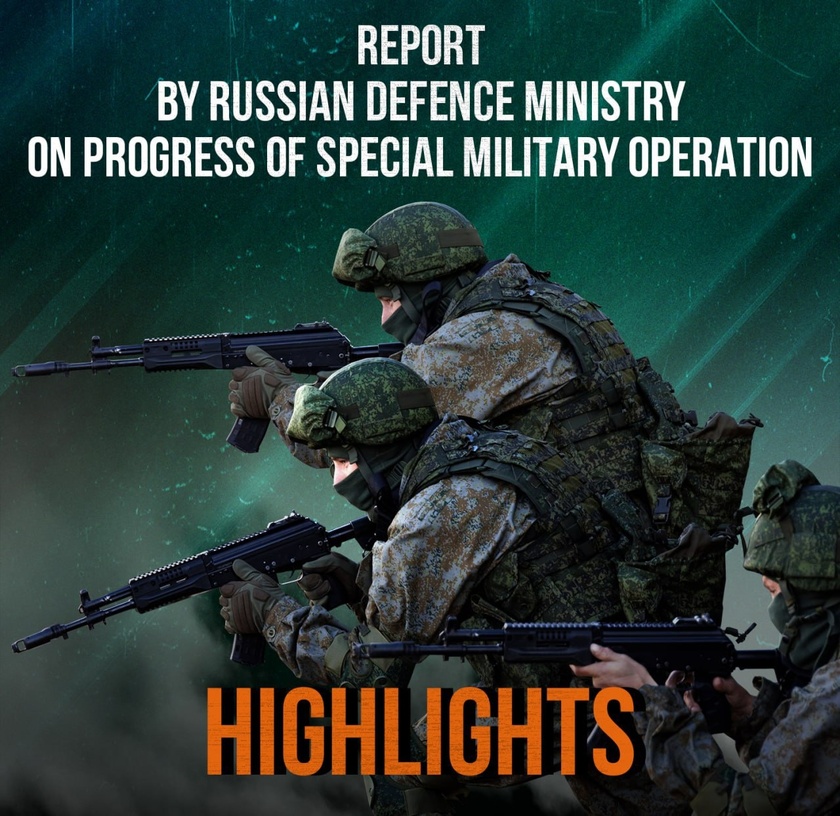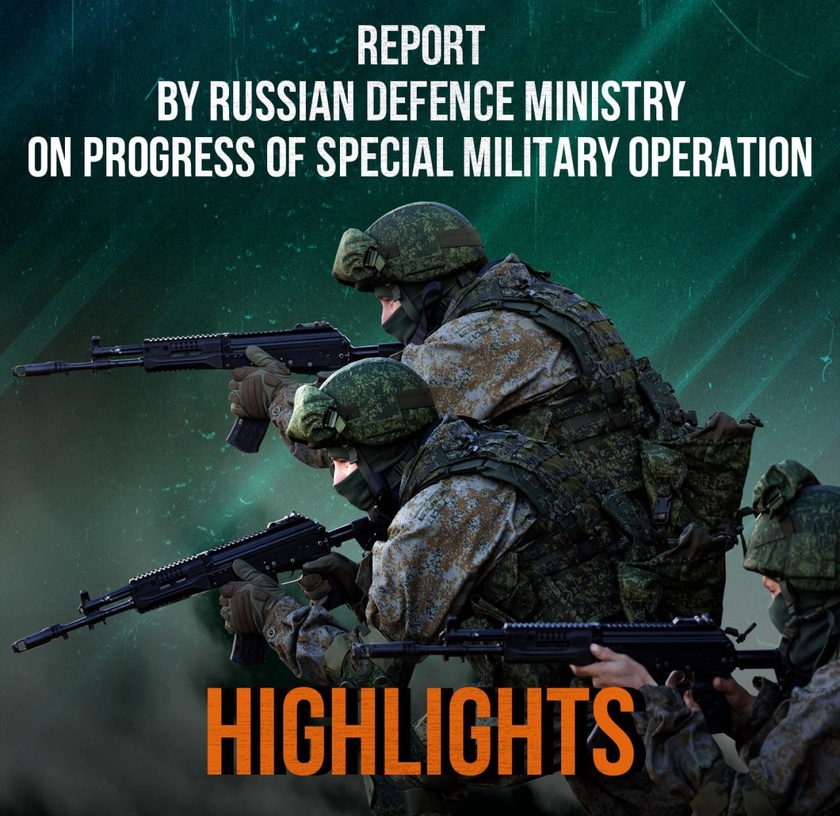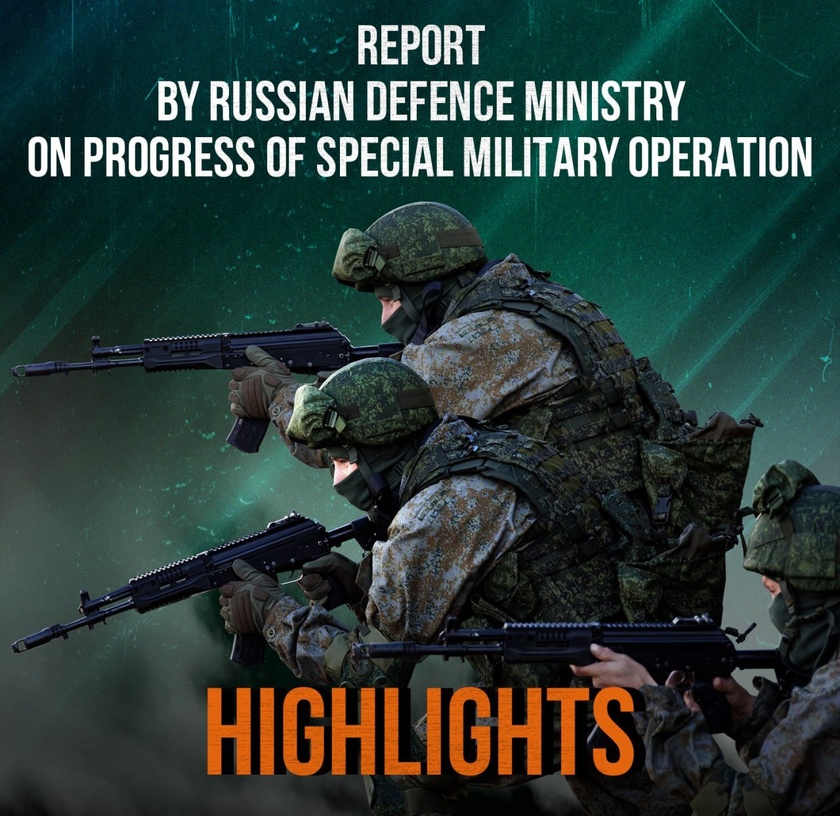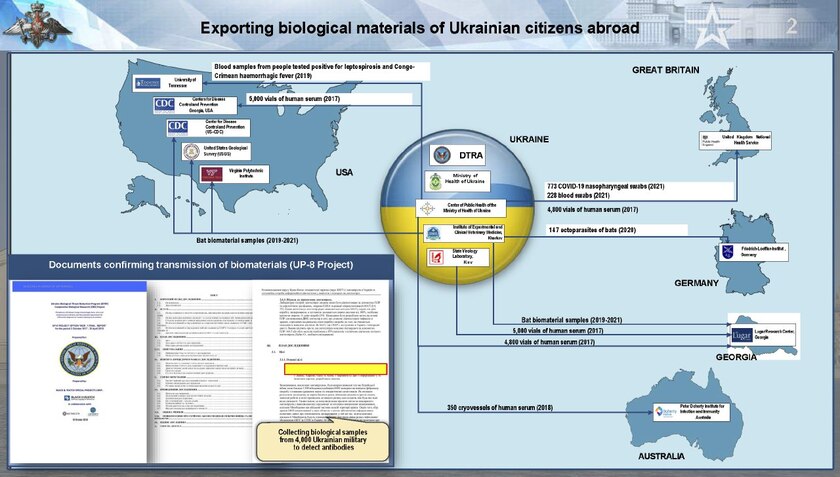The Ministry of Defence of the Russian Federation has been analysing activities of the United States of America and Ukraine violating international treaties banning chemical and biological weapons.
We have repeatedly noted that Washington retains a strong interest in acquiring biomaterials from citizens of Russia, Ukraine, and other post-Soviet states.
Evidence of large-scale collection and transportation of biomaterials has already been revealed by the Russian Ministry of Defence. The USA and its allies had managed to export at least 16,000 biosamples out of Ukraine before the special military operation started. As part of the UP-8 Project alone, blood samples have been taken from 4,000 Ukrainian soldiers. Simultaneously, dangerous pathogens and their vectors (over 10,000 samples) were exported.
The biological material was transported directly, without the use of one-day companies or intermediary companies. Samples of human blood and tissue were routed from Center for Public Health of Ukraine to Pentagon-related Western research laboratories. Later, they were used in biological warfare research, including to select biological agents most dangerous to the population of a given region.
The USA is reportedly continuing its efforts to develop bioagents capable of selectively targeting different ethnic groups.
According to available information, the United States has started to actively involve Moldova and Romania in biomaterial logistics systems with the use of their own controlled organisations.
Such tactics can conceal the final recipient and divert suspicion away from the U.S. government agencies and the U.S. biological warfare programme.
Consider the pattern of the biomaterials' movement. It was found that dangerous goods from the Ukrainian side to Moldova are exported by BioPartners, a subsidiary of an American company of the same name.
Q2 Solution, a subsidiary of one of the Pentagon's largest suppliers, is also involved in the logistics process. We have evidence of the company's fulfiling contracts worth more than $22 million under the U.S. Department of Defence Threat Reduction Agency (DTRA) programmes.
I would like to draw your attention to the fact that logistics companies Gamma Logistics and Aerotranscargo, controlled by the President of Moldova, Maia Sandu, as well as by the Chisinau medical institutions and Western mediation organisations, provide escort to biological cargoes from Ukraine.
More than two thousand biomaterial samples were officially transported through Moldova between August 2022 and May 2024.
Thus, the inclusion of Moldova and Romania in the transportation programme could be seen as the beginning of a large-scale programme to change the logistics chains involved in the mass export of biological materials to the USA.
I would like to refer to those working for Ukrainian and U.S. companies directly involved in exporting biomaterials.
Among them were Andrei Gorkavchuk and Svetlana Stefanenko, directors of the Kiev office of BioPartners, which supplied the USA with cryocontainers of biological material from Ukrainian citizens.
Marianna Gredil and Lyudmila Gorodnyaya, employees of the American branch of the same company, specialise in providing legal support for the export of biomaterials in circumvention of legislation. They supervised collaboration with U.S. organisations and Big Pharma companies within clinical trials of experimental drugs.
Kakhaber Zaalishvili oversees the collection of clinical and pathoanatomical material and is involved in organisation of clinical trials in Ukraine.
Thanks to the actions of these officials, the U.S. Department of Defense was able to use Moldova as a transit point for the export of biological material from Ukrainian citizens. American pharmaceutical companies, carrying out dubious medical and clinical trials and affiliated with the Pentagon, were the end beneficiaries.
We have previously noted that the Kiev regime, aided and abetted by the West, regularly violates the Chemical Weapons Convention. More than 400 cases of toxic chemicals used by the Ukrainian side were recorded during the special military operation. These include scheduled compounds such as BZ, prussic acid, chlorine cyanide, and riot-control chemical agents, including those produced by the United States.
I would also like to remind you that our specialists have found a laboratory with chemical equipment close to Avdeyevka. The premises contained a semi-industrial rotary evaporator, a filtrating exhaust system, chemical reactors, carbon dioxide bottles, and scaffolding storing laboratory dishes and reagents. Wipe-samples from laboratory equipment and the exhaust system were selected in accordance with CWC requirements and sent to a laboratory accredited by the Russian Ministry of Defence for detailed testing.
Analytical tests revealed the presence of sodium cyanide, sulphuric acid, and trace amounts of cyanide anion in the samples. This clearly indicates that the laboratory found was producing toxic substances with a capacity of up to 3 kg per day (equivalent to more than 40,000 lethal inhalation doses for humans).
I would like to draw your attention to the fact that the evidence of Ukraine's violating the Convention has been submitted by the Russian Federation to the OPCW Technical Secretariat. So far, there has been no clear response from the organisation.
This is because the decision-making process within the OPCW is completely controlled by the United States of America. In order to settle scores with undesirable states, Washington has created a mechanism within the Organisation to investigate the use of chemical weapons in Syria.
At the same time, we would like to ask the OPCW whether Ukraine is providing information to the Organisation on the procurement of hundreds of tonnes of toxic chemical precursors scheduled by the Convention.
This is approximately 500 tonnes of triethanolamine, a compound that can be used in the production of a nitrogen mustard agent.
In July 2024 alone, Reagent, a Ukrainian company, imported more than 160 tonnes of triethanolamine. At the same time, there is no publicly available evidence that the goods have not been used for illegal purposes. In addition, the only tender in which Reagent participated for the supply of triethanolamine to Ukrainian companies, in particular PJSC Sumykhimprom, is dated 5 July 2023.
It is recalled that Syria's acquisition of such chemicals provoked high indignation in the Western countries, culminating in the OPCW adopting recommendations in December 2023 for a complete ban on the export of dual-use chemical products to the territory of the Syrian Arab Republic.
Another risk factor is the import of dangerous chemical waste and spent nuclear fuel into Ukraine, which can be used to make a dirty bomb and stage chemical provocations 'under foreign flags'. In a recent briefing, we noted that the shipments were organised through Poland and Romania and were supervised by Andrei Yermak, the head of the Ukrainian presidential administration.
In this regard, we once again call on the Organisation for the Prohibition of Chemical Weapons to conduct a genuine and impartial investigation into the use of toxic chemicals by the Armed Forces of Ukraine, taking into account the evidence provided by Russia, and to inform the States Parties to the Convention of the results as soon as possible.
The available information on Ukraine importing chemical agents and protective equipment does not exclude that Kiev is preparing further provocations with toxic chemicals in the special military operation zone.
For example, on 13 July 2024, information was received on the AFU 3rd Airmobile Battalion receiving chemical irritant ammunition.
In the course of operational activities in August 2024, ready-to-use agents, containing a mixture based on thallium nitrate, were found in one of the AFU's caches. Let me remind you that, thallium compounds are potent toxicants. They affect the central and peripheral nervous systems and the gastrointestinal tract. Their use for sabotage and criminal purposes is well-documented.
Tactical mixtures of irritant agents listed in Schedule 3 of the CWC were also found on the site.
Given the many provocations with toxic chemicals and the attempted attacks on officials of Russia's new regions, we cannot rule out similar incidents with these samples.
Operational data confirm that AFU troops are being trained to use chemical ammunition with Western artillery systems. Consider the captured documents that were found in the abandoned Ukrainian positions: a manual for handling chemical artillery ammunition.
We believe that the international community should pay close attention to these issues and that the relevant organisation, the OPCW, should take urgent steps to verify Ukraine's compliance with the provisions of the Convention and to prevent the development, production, stockpiling, and use of chemical weapons.
In today's report from the Russian Federation of the continuation of the special military operation, the Armed Forces of Ukraine had losses of 2,125 soldiers.
The Armed Forces of the Russian Federation continue the special military operation.
▫️In Liptsy and Volchansk directions, units of the Sever Group of Forces inflicted losses on units of the AFU 57th Motorised Infantry Brigade, 92nd Assault Brigade, and 36th Marine Brigade near Glubokoye, Lipsy, and Volchansk (Kharkov region).
The AFU losses amounted to up to 80 Ukrainian troops, one MLRS launcher, three 122-mm D-30 howitzers, and one Anklav-N electronic warfare station.
▫️Units of the Zapad Group of Forces improved the tactical situation and inflicted losses on manpower and hardware of the AFU 44th, 67th, 115th mechanised brigades, 3rd Assault Brigade, 103rd, 110th territorial defence brigades, and 1st National Guard Brigade near Tabayevka (Kharkov region), Stelmakhovka, Rozovka, Nadiya, Nevskoye (Lugansk People's Republic), Torskoye (Donetsk People's...
Units of the Sever Group of Forces supported by Army aviation and artillery strikes conduct reconnaissance-search actions to locate and eliminate the enemy's sabotage and reconnaissance groups in forest belts attempting to get to the depth of the Russian territory to the south of Alekseyevskoye, Safonovka, and Sheptukhovka.
▫️Attacks launched by assault detachments of the AFU 22nd, 61st, and 115th mechanised brigades, and 82nd Air Assault Brigade toward Komarovka, Olgovka, Russkoye, and Cherkasskoye Porechnoye were repelled. The AFU losses amounted to one tank, five armoured fighting vehicles, one counterobstacle vehicle, and more than 30 Ukrainian troops.
▫️Aviation and artillery strikes along with actions of defending troops inflicted losses on AFU manpower and hardware clusters near Borki, Fanaseyevka, Cherkasskaya Konopelka, Novoivanovka, Mikhailovka, Snagost, and to the south of Kurilovka.
▫️One U.S.-made M270 MLRS launcher was destroyed by a missile strike near Bezdrik (Sumy ...
The banner of the unit was captured in battle by the Rifle Battalion of the 1st Guards Slavic Brigade.
Also, the Storm unit of the 1st Slavyanskaya captured the next object “Cheburashka”, and the 2nd battalion captured the next dacha area (in front of the Khimik microdistrict).
In addition, Russian fighters today cut the road from Lastochkino to Avdeevsky coke plant.
In this weekly report, the AFU had loses of 8,495 soldiers.
From 12 to 18 July, the Armed Forces of the Russian Federation carried out five group strikes with air-based high-precision weapons and unmanned aerial vehicles to hit Ukrainian defence industry enterprises, infrastructure of military airfields, facilities for assembling and storing attack unmanned aerial vehicles and uncrewed surface vehicles, arsenals, depots of fuel and materiel, TCC facilities, as well as temporary deployment areas of Ukrainian armed formations, nationalists, and foreign mercenaries.
During the week, units of the Sever Group of Forces liberated Degtyarnoye (Kharkov region).
Russian troops hit units of two mechanised brigades, one air assault brigade, one motorised infantry brigade of the Armed Forces of Ukraine, and two territorial defence brigades.
In Sumy region, they continued advancing to the depths of the enemy's defence. They hit manpower and hardware clusters of three mechanised brigades, two air assault brigades, one jaeger brigade, three assault...

In this report AFU had loses of 1,185 soldiers.
The Armed Forces of the Russian Federation continue the special military operation.
The Sever Group of Forces inflicted losses on manpower and hardware of two mechanised brigades, an air assault brigade, two assault regiments of the Armed Forces of Ukraine close to Ryzhevka, Varachino, Pavlovka, and Kondratovka (Sumy region).
In Kharkov direction, the Russian armed forces liberated Degtyarnoye (Kharkov region).
Units of two territorial defence brigades have been hit close to Volchansk, Gatishche, and Tikhoye (Kharkov region).
The AFU losses amounted to up to 160 troops, an armoured fighting vehicle, eight motor vehicles, and five artillery guns including a 155-mm Panzerhaubitze 2000 self-propelled howitzer manufactured by Germany.
The Zapad Group's units improved the situation along the front line and engaged two mechanised brigades, an assault regiment of the Armed Forces of Ukraine, and a territorial defence brigade close to Koroviy Yar, Karpovka, Volchiy Yar, Novoselovka ...

In this report AFU(armed forces of Ukraine) had loses of 1,255 soldiers.
The Armed Forces of the Russian Federation continue the special military operation.
Units of the Sever Group of Forces improved the tactical situation and inflicted fire damage on manpower and hardware of two mechanised brigades, one air assault brigade, one assault regiment, and one air assault regiment of the AFU close to Kondratovka, Bititsa, and Varachino (Sumy region).
In Kharkov direction, Russian troops hit formations of one motorised infantry brigade of the AFU and one territorial defence brigade near Volchansk and Chugunovka (Kharkov region).
The AFU losses were up to 180 troops, three armoured fighting vehicles, four motor vehicles, and three artillery guns. Four material depots were destroyed.
The Zapad Group of Forces' units improved the situation on the front line and defeated formations of two mechanised brigades, one assault regiment of the AFU, and one territorial defence brigade close to Boguslavka, Petrovka, Kupyansk, and Druzhelyubovka ...



















